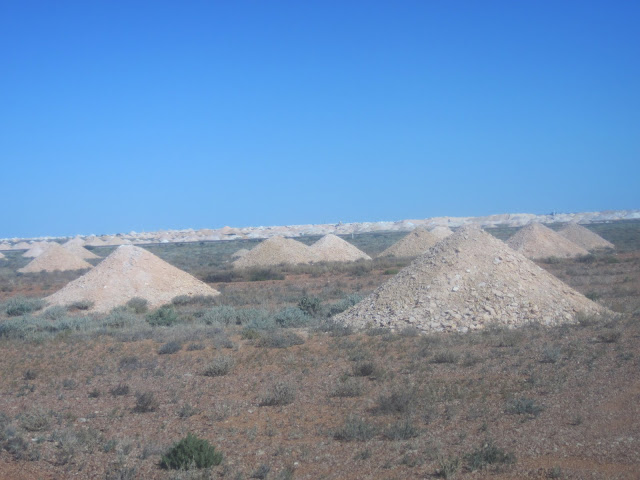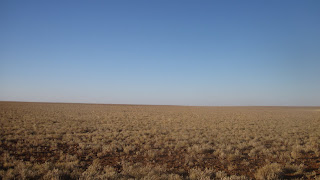 |
| Coober Pedy |
 |
| Kulgera bus stop |
 |
| Fred Flinstone never had it so good |
 |
| Underground Motel |
 |
| Passing a "road train" |
 |
| There is an open mine shaft next to each mound. |
 |
| It's called a blower but it really sucks. |
 |
| Watch your step |
 |
| Sederbian Church |
 |
| One for the road |
 |
| The golf course - FORE! |
 |
| One of the "greens" |
The golf club gave an opal mine to St. Andrews in Scotland and in return received reciprocal playing rights (okay so it’s only at the Balgove Course and not the Links, but still); the letter of thanks from St. Andrews is posted in the Old Timers Museum and is pretty funny.
 |
| The Breakaways, an ancient seafloor, and one lucky bloke! |
 |
| The Sleeping Camel - part of the Breakaways |
 |
| The moon if it had shrubbery |
 |
| The Dog Fence - used to keep mongrel dogs out |
Again because of all the rain I had the chance to view another once in a lifetime occurrence, a full Lake Eyre. Avast inland salt lake, the Lake Eyre Basin covers about 1/6 of Australia. During the rainy
season most of the runoff from ariund Australia drains into northern Lake Eyre. Southern Lake Eyre is usually a dry salt flat similar to our Bonneville Salt Flats. Land speed records have been set on the Lake Eyre salt flat. It is rare that the lake spills over from the north into the south and fills completely; this has happened only three times in the last 150 years. It wasn’t on my original agenda but I couldn’t pass on the opportunity so after Mike gave me a ride to the Coober Pedy airport, I boarded a small 6 seat propeller plane for the 2 hour flight out to Lake Eyre. Lucky me, I got to sit in the co-pilot seat. We took off and headed East into the sun. The plane was noisy and you had to wear a microphone headset to protect your ears and be heard. Going out we flew at ~1500 feet. It was awesome. From the air you get a very good view of all the holes dotting the land around Coober Pedy and staying low you could really see the changing landscape. We started with the basic desert scrubland, crossed
barely 500 feet above a small set of hills, and moved on to a landscape of vegetation covered sand dunes that litterally looked like waves rolling across the land below. The color palette changed from a green background with brown patches, to brown background with green patches, and when we later flew towards the PaInted Hills, a red background with green and brown patches. You could also see the green snakes of vegetation following the now dry riverbeds and the arrow straight, rusty-orange, unsealed roads reaching out to infinity. In the distance we saw this huge blue body of water glimmering in the brilliant sun. Lake Eyre is big but our pilot guide Peter said that the average depth is just 10 centimeters with the deepest part only 1 meter and it is 2.5 times saltier than the Dead Sea. We flew low, ~1000 feet, as we did a couple turns around the southern edge of the lake, and the lowest spot in Australia, before landing for a break at William Creek Station; population less than 10. They just paved their runway a few years ago and there is a hotel and a bar (of course). Every place we stopped in the outback, no
matter how remote, has a bar. Back in the air we headed for the Painted Hills; ancient sandstone mountaintops slowly eroding over eons into colorful works of art. Their color makes them look like the aftermath of an open pit mining
operation, but the colors are all natural. The hills lie on the property of Anna Creek Station which severely restricts access. Pete said not even Anna Creek employees can visit the hills and the only way to view them is from the air. We headed
back over the opal fields and the open holes to Coober Pedy. I noted as we landed that the airport is surrounded by opal mines and actually sits atop the opal minefield. I’m surprised no one has yet dug a hole into the runway. My guess is there are probably some tunnels from nearby mines running under the airport.
 |
"Yes I do know how to fly the palne and stop taking my picture" |
 |
| Flying out over Lake Eyre |
 |
| William Creek Station |
 |
| The Painted Hills |
matter how remote, has a bar. Back in the air we headed for the Painted Hills; ancient sandstone mountaintops slowly eroding over eons into colorful works of art. Their color makes them look like the aftermath of an open pit mining
operation, but the colors are all natural. The hills lie on the property of Anna Creek Station which severely restricts access. Pete said not even Anna Creek employees can visit the hills and the only way to view them is from the air. We headed
 |
| That's a lot of holes |
 |
| Crash landed |
There are many other quirky things and characters in Coober Pedy. The first tree “planted” is made of welded iron beams; old movie props abound; the Italian family who despite the cost of water has a garden with flowers, a lemon tree and a fountain; and “Crocodile Harry”. Crocodile Harry was a crocodile hunter from the Northern territory who once killed 89 crocs in one day and is most likely the inspiration for the movie “Crocodile Dundee”.
When crocodile hunting became illegal, he moved to Coober Pedy and mined opals. Harry died a few years back but you can visit his underground “home”; a series of caves, filled with indescribable paraphernalia, that was used in the movie "Mad Max: Beyond Thunderdome". He was quite a character; you’ll have to look him up on the internet to learn more.
 |
| Inside "Crocodile Harry's" Home |
They say if you stay in Coober Pedy more than two days you will stay forever. There is some truth to aphorism; something seductive pulls at your soul. I asked Mike about it, he said it's the freedom; I think the people have a lot to do with it as well. One more day and I would become one of the mole people, carving a dugout and never leaving; it's that alluring. I'd love to come back to Coober Pedy someday, so if everyone wants to chip in a fews bucks, I'll travel the thousands of miles, cross the dry desert sands, to come to a place in the middle of nowhere, live underground, dig a few holes, and maybe, just maybe find us a fortune in opals.
 |
| This could be ours |
Literally from down under.
norb
No comments:
Post a Comment